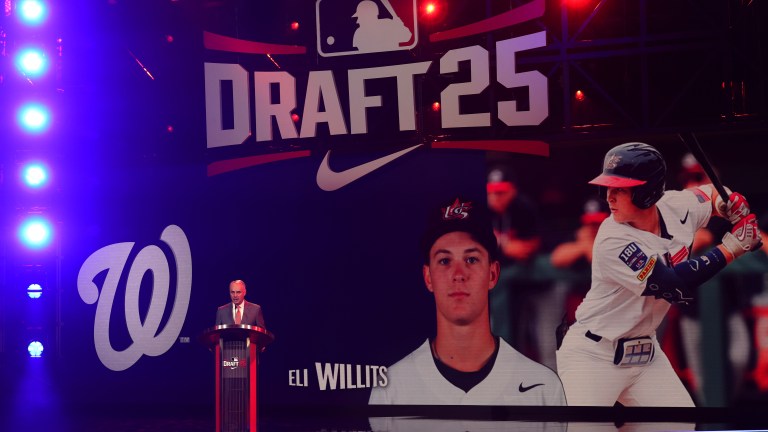Was Eli Willits the Right Choice for the Nationals’ First Pick?
While some thought the Nationals made the right choice taking Willits with the first overall pick, others raised their eyebrows.

Ahead of this year’s MLB Draft, fans of the sport knew we were in for a chaotic draft. Up until moments before the Washington Nationals went on the clock, there still wasn’t a clear number one player in the entire class, especially with the Nationals’ draft team having a recent shakeup.
The Nationals had fired general manager Mike Rizzo and manager Dave Martinez ahead of the draft, making this choice even more difficult for the club. With plenty of good players available and no clear number one, they could go in any direction they pleased.
When it came time for their selection, the Nationals took shortstop Eli Willits with their first overall pick. Immediately, the reaction was split, with some people thinking this was the right choice and others raising their eyebrows at the decision.
With there being many pros and cons to Willits and other prospects early in the draft, it’s tough to definitively say if the Nationals made the right choice. Let’s take a closer look and attempt to answer this question.
Breaking Down Willits as the First Overall Pick
When attempting to answer the titular question, we first have to take a closer look at Eli Willits’ game and break down what makes him so great. Before the draft, our Tyler Jennings ranked him as the fourth-best prospect in the draft on his top 315, giving him a lot of praise in the process.
Playing in the same high school circuit as the fourth-overall pick, Ethan Holliday, Willits dominated, catching the attention of scouts regularly. He reclassified from the 2026 MLB Draft, making him the youngest player ever selected with the first overall pick.
Despite being just 17 years old on draft day, Willits was one of the toolsiest players in the entire class, not just in the first round. He’s a switch hitter, and a legitimate one at that. This isn’t common, let alone for a 17-year-old prep prospect.
He’s shown the potential to keep switch-hitting in professional baseball, taking fantastic swings from both sides of the plate. He’s short and long through the ball, giving him the ability to drive the ball into the gap regularly. While his pop has room to grow, with his age, we could see this become above-average in no time.
When it comes to his skills in the field, there’s no doubt that Willits will stick at shortstop later down the line. He’s shown elite range and the athleticism needed to play the position long-term, both being valuable qualities. His sheer athletic ability gives him some solid speed, too.
On paper, Willits had a real argument for being the best prep prospect in the entire draft. However, for the Nationals, this was also quite the genius money-saver, and it played out big time. Not only did they land arguably the most talented prep prospect in this year’s class, but this helped them land some big-time names later in the draft.
Of their first five picks in the class, four were high school prospects. The Nationals were able to land right-handed prep pitchers Landon Harmon and Miguel Sime Jr., both overslot choices, and they should be able to use their savings to sign them easily.
Harmon and Sime both possess really good qualities, with both of them having some of the best fastballs in the entire draft. While many individuals thought the Nationals would take some much-needed pitching help with the first pick, these two fastball-heavy arms are a different but valuable approach.
They were also able to land Coy James quite far over slot, 87 picks to be exact, if you go by our most recent top 315 draft prospects list. James was widely regarded as one of the more interesting prep bats in the class, with his power leading his offensive profile.
The one collegiate prospect the Nationals landed in their top five picks was none other than Ethan Petry, one of the more electric power bats in college baseball. He hit 54 homers across three collegiate seasons, showing his strengths.
The Nationals went pretty heavy on collegiate prospects after this, but they were able to squeeze in two other potential overslot picks later in the draft. The most notable one came in round 19, in which the Nats selected two-way player Mason Pike as a pitcher.
While there’s a good chance he doesn’t sign, they wouldn’t have even had this possibility without taking Willits first overall.
It’s almost certain that if the Nationals had targeted any of the other high-end talent with the first overall pick, they wouldn’t have had the budget to draft so many talented prep prospects. Instead, they walk away with a very talented prep class, headlined by Willits.
Other Options On the Board
If the Nationals had gone another way with this pick, there are a few names they could have chosen instead.
The first name that stands out is the other top prep hitter in this class, Ethan Holliday.
Most known for his baseball lineage, Holliday has electric power with one of the best physical makeups in the prep side of the draft. He projects to be a power-first offensive threat, but could still make plenty of improvements in his hit tool. There’s a chance he lands at third base, but given the offensive profile, it’ll be no problem if he doesn’t.
Holliday eventually went to the Rockies as the fourth-overall pick, with reports indicating the Nationals didn’t even check in on his price tag. He’ll almost certainly sign an overslot deal, potentially getting close to $10 million, an amount that handicapped the rest of the Rockies’ draft.
There were also rumblings that Kade Anderson was undoubtedly the number-one choice for the Nationals, especially after how he pitched down the stretch for the National Champion LSU Tigers.
Anderson, a left-handed starting pitcher, was ranked number two on our board, behind only Holliday for the top spot. He’s a projectable arm, as his fastball gets up in the mid-to-high 90s at times. His slider is also very good, giving him a fantastic offering to attack hitters with. In addition, he throws a solid curveball and changeup, giving him a legitimate four-pitch mix.
Anderson eventually dropped to the Mariners with the third-overall pick, where he signed almost instantly for $8.8 million. While this is a hefty price, it’s not high enough that the Nationals would’ve been severely handicapped, but they wouldn’t have been able to draft as many high-end prep bats as they did.
There were also rumblings of Seth Hernandez or Liam Doyle being the correct choice for the Nationals with the first pick, both of whom went back-to-back at picks five and six overall.
Doyle was projected to be one of the best collegiate pitchers in the draft, while the righty Hernandez had a legitimate argument for being the top player in the draft.
With Anderson signing for $8.8 million, it’s reasonable to assume that both Doyle and Hernandez will sign for less, once again meaning the Nationals may not have been severely handicapped.
When it comes down to it, though, the Nationals did what they thought was best by sticking with Eli Willits as the first overall pick.
Did the Nationals Make the Right Choice?
As for whether or not the Nationals made the right choice, it’s up to personal preference. While Willits may not have definitively been the top player in the class, the Nationals walked away with arguably the best prep hitter in the draft in addition to an impressive group of prep players because they selected him first overall.
The Nationals felt that by taking Willits, they could save enough money to be crafty with their picks later in the draft. While they may not have been heavily affected by taking anyone besides Holliday, there’s always the possibility that Anderson, Hernandez, or Doyle would’ve put them more in the hole financially much earlier on.
The fact that the Nationals need pitching help will come up a lot in this discussion, but they did land multiple very exciting prep arms because of their decision at the top of the draft.
Sime and Harmon both project to be near the top of their rotation in the future, and should be extremely exciting young arms. Plus, there’s always the potential that they could ink White with a rich enough offer.
When it comes down to it, I believe the Nationals made the right choice by selecting Eli Willits first overall. Not only did they walk away with Willits, but they were also able to land other exciting prep players, giving them a less lopsided class than if they had taken a different route.
Suddenly, the already-bright future in Washington, D.C., just got even brighter.
